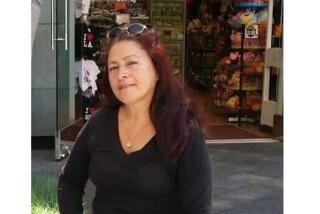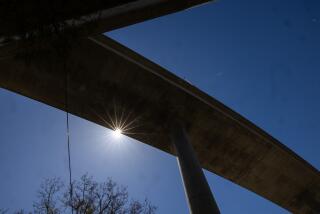Carjacking Robs a Child’s Trust, and Much More : Violence: A 9-year-old is now safe, but she and society continue to pay a price unless we attack the root causes.
- Share via
A cheerful voice greeted us from the McDonald’s menu board. No sooner had I uttered “cheeseburger Happy Meal” when an arm reached in through the window from behind and violently clenched my neck in a chokehold. Amid cursing and threats that my brains would be blown out, my assailant demanded my money.
I immediately complied, handing over my life’s value at the time: about $15. Through it all I could hear, but not see, my 9-year-old daughter, Soledad, crying hysterically: “Please don’t hurt my mommy.” Bruises heal and pain subsides. But the sound of helpless weeping of a small child witnessing real-life violence still provides the soundtrack in recurring dreams.
Psychological profiles of assailants vary, and who knows why in our case he then ordered us out of the car. Though still a prisoner of his chokehold, hearing the promise of freedom heightened my emotional trauma: I must trust and believe that this human being would not harm us further. My purse, my wallet, my BMW; nothing mattered in those seconds as much as crawling out of the car, even as I feared that it could all be a cruel hoax and we’d be blown away, or that he might panic, driving off with my child. But once we were out of the car and he was in it, my assailant drove off. Mother and child hugged.
Days have passed. The throbbing in my head has ceased. The bruises are healing and the soreness in my upper body is dissipating. But most survivors of violent crime find that the process of healing poses substantive challenges. Soledad now jumps when she hears unexpected sounds. She fears the carjacker will return. Two days after the incident, my sister treated us to a matinee to escape from it all. Shortly into the movie there was one of those Hollywood “comic” muggings. It didn’t seem so funny. We left.
We are safe now, but I know it will take time to work through. I did all the right things: I remained calm, gave him my money, gave him my car. In return, he released us. Yet, on my first day back to work I read the front-page Los Angeles Times article regarding a Northridge mother about my age, who, in the presence of her 9-year-old child, also did all the right things. But her assailant killed her. It was then that I finally allowed myself to stop acting “calm” and broke down and cried: for the dead mother and her surviving child, as well as for me and my child. And in the craziness of our society where the rules of who lives and who dies have become all too arbitrary, I even silently thanked our attacker for letting us go.
Ironically, The Times had profiled carjackings the previous week. LAPD’s Crime Prevention Office estimates that carjackings represent less than 9% of all auto thefts in Southern California; 7,000 carjackings occurred in Los Angeles last year, up from 4,500 in 1991.
Certainly, immediate steps can be taken to ensure greater safety in similar circumstances: Restaurants should eliminate rear drive-through lanes. Walls and shrubs that can provide cover for would-be assailants should be removed. Where this cannot be done, security guards might be provided. Good lighting and the use of video cameras should be the norm.
After wrecking our car, our assailant was arrested and we were taken to identify him. Even as I saw him--feeling the bite of cuffs around his hands as surely as I had felt the bite of his hands around my neck--I felt no great relief. For overall, society does little to prevent crime. While enhanced security must take place, merely hiring more officers is not the answer.
Soledad and I will be better human beings in the process of working through this experience. But profound structural changes in the fabric of society’s infrastructure--including access to housing, education, health and employment--which fundamentally impacts the quality and value of our lives, needs to occur before our generation, or that of our children’s, will truly be safe.
More to Read
Sign up for Essential California
The most important California stories and recommendations in your inbox every morning.
You may occasionally receive promotional content from the Los Angeles Times.










